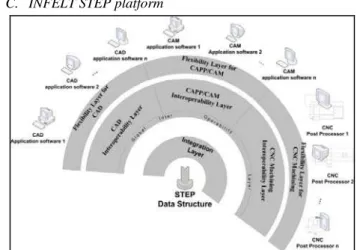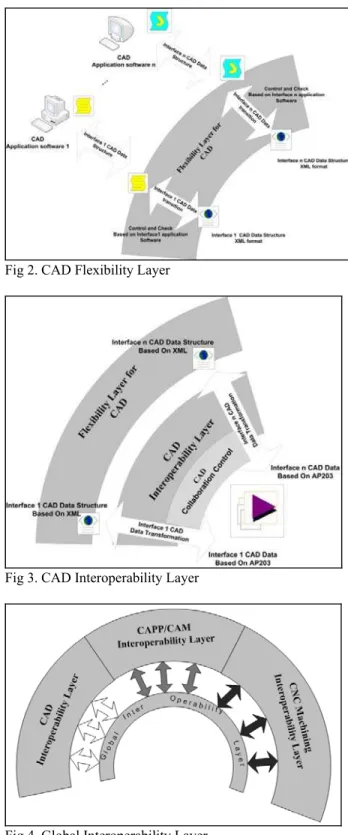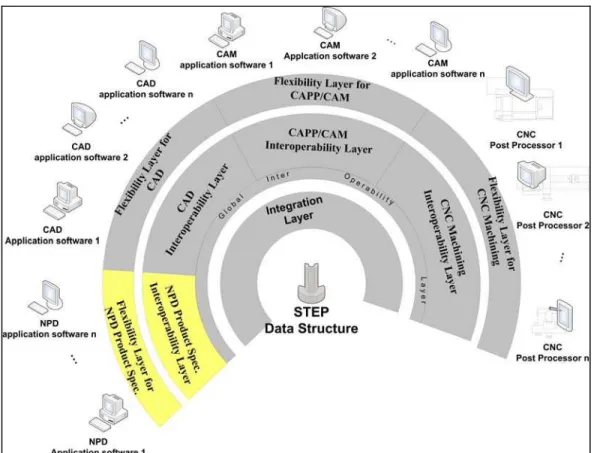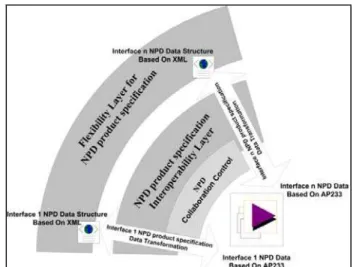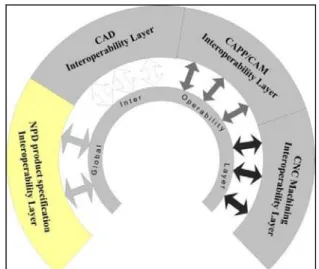Abstract— Today’s information technology capabilities enable the enterprises to increase the manufacturing collaboration and interoperability among their different departments. These departments are engaged in different product development processes from design to manufacturing. INFELT STEP is a three-layered platform. These layers have functions and structures that enable the INFELT STEP platform to manage the product development collaboration among different CAD/CAM application software with an integrated product data structure. INFELT STEP has structures and functions in its interoperability layer that enable different CAD/CAM application software and CNC post processors to use their own data structures for interoperable product development. INFELT STEP has an integrated data structure based on STEP (ISO 10303) standard. This article extends the INFELT STEP architecture to improve its capabilities to integrate enterprises product information based on STEP (ISO 10303) standard. By this extension, INFELT STEP is capable of managing collaboration among New Product Development (NPD) processes and CAD/CAPP/CAM software in an interoperable environment. The paper will discuss the NPD and CAD/CAPP/CAM integration based on INFELT STEP platform. The collaborative environment and STEP based data integration between product specifications activities in NPD processes and CAD/CAM efforts in product development processes reduces time to market and insure the product capabilities for answering the customers’ need. The different aspects of this integration will be described in INFELT STEP platform.
Index Terms—Design and manufacturing interoperability, New Product Development (NPD), CAD/CAPP/CAM integration, ISO 10303 (STEP) standard.
I. INTRODUCTION
In New Product Development (NPD) processes, appropriate and stable product specifications are important factors that enable the enterprises to achieve to the goals like fast time to market and capacity utilization [1]. During these processes, when the customer needs and market conditions are searched,
Omid Fatahi Valilai was with industrial engineering department as a Msc student, Sharif university of technology, P.O.Box : 1155-9414, azadi road, Tehran, Iran. He is now the president of Parsian Enterprise Architecture ltd, University of Tehran Science and Technology park, Tehran, Iran(omidfatahi@gmail.com).
Mahmoud Houshmand is with the industrial engineering department as an associated professor, Sharif university of technology, P.O.Box : 1155-9414, azadi road, Tehran, Iran (hoshmand@sharif.edu).
product specifications should be developed. Features (characteristics of the product) are one of the important information that should be gathered in product specifications activities during NPD processes [2]. These features influence the product design and product manufacturing processes. The Product design process starts with a careful analysis of customers’ needs in terms of features, functions, and benefits of the product [3]. Therefore, the integrated information exchange between “NPD processes” and “product design”, “product process plan design” can lead to short time to market and higher ability of the product to satisfy the customer needs. These benefits will be improved highly if the application software engaged in NPD product specification processes and CAD software can collaborate with each other and exchange their product information in an interoperable environment.
A. New Product Development
The importance of new product development (NPD) has grown dramatically over the last few decades, and is now the dominant driver of competition in many industries [4]. Considering automotive, biotechnology, consumer, and industrial electronics, computer software and pharmaceuticals industries, they often depend on products introduced within the last five years for more than 50 percent of their annual sales. However, new product failure rates are still very high. Many R&D projects never result in a commercial product, and between 33 and 60 percent of all new products that reach the market place fail to generate an economic return [4].
In a tough business environment, innovation is the only route to gaining and sustaining competitive advantage. In the past few years, governments, journalists, chief executive officers and academicians have embraced innovation as the new Holy Grail for the future development of countries, industries and firms [5].
New product development has become central to achieving meaningful differentiation. NPD cycles get shorter as the innovations of the others render existing products unnecessary [6]. A crucial problem in new product development efforts is to reduce the time required for their design and manufacture while still maintaining high quality and minimum development cost. To achieve this, inputs are needed from experts in a multitude of disciplines as well as
Extended INFELT STEP: An interoperable
Platform for managing collaboration among new
product development applications and
CAD/CAM software Integrated based on ISO
10303 (STEP) Standard
from customers and suppliers. The overall design process must be well orchestrated and integrated [7].
Product development can be defined as the process by which the inception, conception, development, realization, maintenance and demolition/decommissioning of a facility (constructed works) can be described and managed [8].
B. ISO 10303 (STEP) standard
Since the mid-1980s, the international community has been developing the ISO 10303 set of standards, well known as STEP (ISO 10303-1 1994), which has its foundations in many of the earlier aforementioned standards [9]. STEP has developed from a group of people popularizing emerging ideas through cycles of consensus, much as do schools of art, literature, and music [10]. The STEP standard is divided into many parts, i.e. Description Methods, Information Models, Application Protocol (AP)s, Implementation Methods, and Conformance Tools. Each part is published separately [11]. The Information Models and Application Protocols describe the data structures and constraints of a complete product model [9]. The use of STEP language can help the enterprises to have to somehow the integration of data for product design activities [12]. The overall objective of STEP is to provide a mechanism that is capable of describing product data throughout the life cycle of a product, independent from any particular system [13]. STEP has led to improvements in exchange and sharing of simple CAD information, product models and complete product structures and Furthermore, STEP has improved communications within the extended enterprise (including suppliers, business partners and customers) and helped to support global collaborations [12]. This standard can manage the design information in an integrated environment.
The first parts of STEP publication to achieve International Standard status happened in 1994, but many other parts have since been published or are under development and will eventually be added to the standard [14]. STEP has capabilities that span multiple industries. Those industries driving and actively developing standards today include architecture & construction, aerospace, automotive, electrical & electronic, manufacturing technologies, process plant, and shipbuilding [10]. Recent updates (and other relevant details) can be found at the following websites: http://www.nist.gov/sc4,www.tc-184-sc4.org, and http://www.iso.ch/iso/en/ISOOnline [14].
ISO 10303, also informally known as the Standard for the Exchange of Product model data (STEP), is a family of standards defining a robust and time-tested methodology for describing product data throughout the lifecycle of a product [15]. When the STEP effort began in 1984, it was envisioned as a more encompassing set of standards for the exchange of all product data that included CAD/CAM and Product Data Management (PDM) systems [16]. STEP is widely used in computer-aided design (CAD) and product data/lifecycle management (PDM/PLM) systems [15]. The ISO10303 and ISO14649 Standards (STEP and STEP-NC) have been developed to introduce interoperability into manufacturing enterprises to meet the challenge of responding to production on demand [17]. It is stated that Major aerospace, automotive, and ship building companies have proven the value of STEP through production implementations resulting
in actual savings of $150M per year in the US (and potential savings of $928M per year) [15].
STEP is a proactive effort, the focus being placed on developing a standard that caters for various user groups, which are usually associated in an industry or according to a common application such as CAD data, which can be used throughout multiple industries [18].
The STEP standard categorizes the various types of product data around APs. An AP includes at least three formal documents:
The Application Activity Model (AAM) describes the activities in the lifecycle of a product.
The pieces of product information that are needed for the activities are called the Application Reference Model (ARM) The Application Interpreted Model (AIM) is formed by using an EXPRESS information model to capture everything in the ARM and to tie it to a library of pre-existing definitions [9].
STEP will enable us to iterate designs based on manufacturing suggestions, then evaluate and analyze the results before manufacturing the pieces. It also offers a tremendous benefit for exchange and managing information from several engineering and manufacturing disciplines in an effective way [19].
Some of the most relevant APs used in the CAD/CAM domain include [9], Part 203: Configuration controlled 3D designs of mechanical parts and assemblies (ISO 10303-203 1994), Part 214: Application protocol: Core data for automotive mechanical design processes (ISO 10303-214 1994) and Part 224: Application protocol: Mechanical product definition for process plans using machining features (ISO 10303-224 2001).
C. INFELT STEP platform
Fig 1. INFELT STEP platform overall Structure
Integration layer maintains the integrity of product data based on STEP standard as shown in Fig 6. The Interoperability layer control and manage the collaboration among different CAD/CAM application software and CNC post processors as shown in Fig 3 and Fig 4. The Flexibility layer is comprised of interfaces. These interfaces exchange the CAD/CAM data with CAD/CAM application software and CNC post processors as shown in Fig 2. The Integration layer stores the product data based on STEP application protocols. The CAD product data are stored based on application protocol 203. The product data related to product process are stored based on application protocol 214& 224. The CNC machining data are stored based on application protocol 238. INFELT STEP has procedures and functions that exchange the data with different CAD/CAM application software and CNC post processors. These procedures and functions manage the modified product data.
INFELT STEP data structure is integrated based on (ISO 10303) STEP standard. The different CAD/CAM application software can collaborate with each other in product design and product process planning in this platform.
D. Proceeding research
The INFELT STEP is capable of managing product design data and the data related to the product process plan based on STEP standard. As the stated earlier, definition of product specification during the NPD process is highly important. This paper proposes an extension to the INFELT platform to manage the NPD activities during the product specification processes definition and integrate it with product CAD/CAM activities. This integration will be based on ISO 10303(STEP) standard. The proposed extension will use the information technology capabilities of INFELT STEP to integrate the NPD processes with Design activities. The collaborative product development environment enables the data interoperability among different NPD software and CAD/CAM application software. This reduces the time needed for product design based on product specification data so reduces time to market and increase the product capabilities for satisfying the customer needs.
The paper discusses the different aspects of this extension in extended INFELT STEP structure. The information requirement needed to add the new interfaces to the platform will be discussed. The extended INFELT STEP structure will maintain the integrity of product data based on STEP standard. At the same time the extended INFELT STEP platform, enable the different NPD software and CAD/CAM application software to exchange the product data based on their own data structure and manages the collaboration among them.
II. THE PROPOSED EXTENSION IN INFELTSTEP PLATFORM The proposed extension in INFELT STEP platform should enable this platform for integrating NPD processes based on STEP standard. It should also enable different application software to collaborate with each other in specifying the new products specifications. The extension should include a data structure capable of maintaining NPD data based on STEP standard. It also needs procedure and functions in INFELT STEP structure to manage the collaboration with different application software in NPD processes. In order to maintain
the NPD product specification data integrated based on STEP standard, the paper proposes to extend the data structure based on STEP standard. This extension includes the use of the data structure based on application protocol 233 in integration layer.
Fig 2. CAD Flexibility Layer
Fig 3. CAD Interoperability Layer
Fig 4. Global Interoperability Layer A. ISO 10303-233 (AP 233)
from a set of reusable information model “modules” for compatibility across application domains [21]. Since 1999, STEP has extended its scope from the product design phase to additional lifecycle phases, such as maintenance and repair, including AP239 (Product Lifecycle Support [PLCS]) and AP233 (Systems engineering data representation) [12]. AP233 is designed as a neutral information model for the exchange of data between Systems Engineering, Systems Architecture Description, and related tools. In most cases, the specifications within this site are the definition of mappings between the schema or metamodel of an application, database or standard and the AP233 XML Schema. This documentation is self-contained so that readers need no knowledge of the AP233 ISO standard itself or the ISO EXPRESS language in which AP233 is standardized [22].
AP233 is a STEP-based data exchange standard targeted to support the needs of the systems engineering community, consistent with emerging standards in CAD, structural, electrical, engineering analysis and support domains. Application Protocol (APs) parts address specific products and processes. AP 233 is addressing Systems Engineering and Design using a combination of modules the systems engineering team has developed and modules that other teams have developed. The scope of AP 233 includes: 1) System behavior
2) System structure 3) System modeling 4) Decision support
5) Requirements, analysis, trade studies 6) Program and project management 7) Verification and validation 8) Risk management
9) Issue management
AP233 was proposed aiming to support the exchange and sharing of systems engineering data [12]. This helps the system analyzers to gather and develop the main properties of product successfully.
Fig 6. Integration Layer
AP233 and several other STEP application protocols are being built using a modular architecture. This enables the same information model to be reused across disciplines and life cycle stages. In the STEP Modular Architecture these reusable information models are called application modules, or informally called “modules”. AP233 will consist of a number of modules that together will satisfy the scope of the requirements stated above, [23]. So using AP233 for gathering product specification along the modules will be used for other parts in later product lifecycle part. Support for several of systems engineering viewpoints within the scope of AP233 already exist as the result of the development of
other application protocols and will simply be reused in AP233. When existing STEP modules do not provide needed capabilities, new modules are being defined as part of AP233 development. Since AP233 is part of STEP, it is easy to relate systems engineering data to that of other engineering disciplines over the lifecycle of a system and to related product models [23]. These modules will be used for other APs in product design and product process design.
B. The Proposed extended INFELT STEP platform for Integration with NPD processes
The proposed extended INFELT STEP platform is shown in Fig 5. The integration layer uses the ISO 10303-233 (AP233) to manage the NPD processes. The product specification gained from different application software will be stored based on this data structure. This makes the INFELT STEP integrated based on STEP standard. The different CAD/CAM application software can then use the NPD data based on STEP standard for product design and product process planning.
The extended INFELT STEP platform has two new layers. These layers are NPD flexibility layer and NPD interoperability layer. These layers support different NPD software to collaborate with each other in specifying the product specification. The NPD interoperability layer converts the NPD data. This data is converted to data structure based on AP233 data structure. The global interoperability layer is also active in this part and manages the collaboration between all the NPD and CAD/CAM application software.
1) Extension in Flexibility Layers
To enable the different NPD software to collaborate in an interoperable environment, the paper extends the INFELT STEP platform by means of new NPD flexibility layers. This layer is responsible to send and receive the data and information to the different NPD software based on their own data structure. This layer facilitates to join the new NPD software easily. This layer has data structures based on NPD software data structures. Like other CAD/CAM flexibility layer structures, the NPD flexibility layer is consists of interfaces for each NPD software data structure. The data and information is exchanged based on NPD application software data structure within these interfaces. The developed interfaces are parts of the flexibility layers. The main function of the interfaces in the flexibility layers is to check the data validity of exchanged information. These layers communicate with Interoperability layers in XML data format. With this new flexibility layer, INFELT STEP gets four flexibility layers:
Flexibility Layer for NPD product specification to support different NPD application software, Fig 7.
Flexibility Layer for CAD to support different CAD application software, Fig 2;
Flexibility Layer for CAPP/CAM to support different CAPP/CAM application software.
Flexibility Layer for CNC Post Processors to support different CNC machining post processors.
Any applications and devices use their own data structure. These layers are consists of different interfaces that have data structure based on related NPD/CAD/CAM application software and CNC machining post processor data structure.
Fig 7. NPD flexibility layer structure and functionality These layers send the NPD/CAD/CAM/CNC machining data and information to lower layers named Interoperability layers in XML format. Vice versa, flexibility layers receive the NPD/CAD/CAM/CNC machining data and information from interoperability layer in XML format.
The Flexibility layer for NPD product specification layer enables the INFELT STEP to have flexibility to support different NPD software based on their own data structure. The new interfaces can be developed to this layer where they are required.
2) Extension in Interoperability Layers
These layers are the brain of INFELT STEP platform. Different NPD/CAD/CAM/CNC machining data and information structures in XML format are delivered to these layers. These layers enable different NPD/CAD/CAM software collaboration. To support NPD software for interoperability and collaboration the extension in INFELT STEP interoperability layers include a new interoperability layer for NPD product specification software. This layer is shown in Fig 8.
Fig 9. Extended Global Interoperability Layer structure The new NPD Interoperability layer enables different NPD software to collaborate in the platform. The interfaces in the NPD flexibility layer sends the data and information based on their own data structure in XML format to NPD interoperability layer. The NPD interoperability layers processes the data and convert them to STEP standard data structure based on Application protocol 233 data structure.
As like the other Interoperability layers, in NPD interoperability layer, there is a procedure called collaboration control. After interoperability layer converts the interfaces’ modified data to STEP data structure, collaboration control checks the data. NPD collaboration control ensure that once a NPD application software modified data is received and converted to STEP data structure, it doesn’t contradict with other NPD application software.
To check the processed data and information validity, the interoperability layers check data and information based on STEP standard. If interoperability layers identify any invalid processed data, they will return these data to related interfaces in flexibility layers. If the converted data validate the constraints, the interoperability layers send this data to Global Interoperability Layer.
The Global Interoperability layer has the responsibility to enable interoperability between NPD/CAD/CAM application software and CNC Post Processors. This layer is extended to support the interoperability during the collaboration among NPD and CAD/CAM activities as shown in Fig 9. The Interoperability layers act in two stages:
Captures modified product data and information from their related flexibility layer’s interfaces. They convert those data to STEP structure based on application protocols defined in those interoperability layers. The interoperability layers perform the control and check operation for validating the modified data among their own layer.
The interoperability layers deliver the data to Global Interoperability layers to check and control the modified data among all interoperability layers. The modified NPD product specification data may be in contrast with other scopes like a CAD modification on design that may endanger CAM modified data for that product.
The global interoperability layer interchanges the product data with lower layer called Integration layer. It receives the stored data from Integration layer and processes it to control and validate the modified data.
The Interoperability layers interchange the data among Flexibility layers and Integration layers. At the flexibility layers, each of the NPD/CAD/CAM applications works with their own data structure. The product data is stored in Integration layer based on STEP standard. The role of Interoperability layers can be defined as a medial structure between flexibility and Integration layer. These layers convert the product data to STEP structure and control the modified data with other information stored in Integration layer to avoid the contrasts.
3) Extension in Integration Layer
The extension in this layer should enable the INFELT STEP platform to integrate the NPD product specification data based on STEP standard.
Fig 10. Extended Integration Layer structure and functions
One of the major operations of the INFELT STEP platform is its storage operations. The integration layer is responsible for saving and managing the data. This data is the result of collaborative works. It includes the design of the product, the process plans of the products and the data that lead to the production of this product by means of the CNC machining tools. The extension in this layer adds the AP233 data structure and extra functions for NPD data to current data structures as shown in Fig 10. This enables the Integration layer to send and receive the NPD product specification data and maintains the integrity based on STEP standard.
III. CONCLUSION
product process planning. This links the product specification activities with product design activities. This reduces time to market and increase the product capabilities for customer satisfaction. New extensions for improving the INFELT STEP platform capability in other product development processes can be further searched.
REFERENCES
[1] C. H. Loch, S. Kavadias. Handbook of New Product Development Management . s.l. : Elsevier Ltd., 2008. ISBN: 978-0-7506-8552-8. [2] A. mital, A. desai,A. subramanian,A. mital. product development: a
structured approach to consumer product development, design, and manufacture. s.l. : Butterworth-Heinemann, 2007. p. 17. 0750683090, 9780750683098.
[3] D.L. Rainey. Product Innovation,Leading Change through Integrated Product Development. Cambridge : Cambridge University Press, 2005. Information on this title: www.cambridg e.org /9780521842754. 978-0-511-11296-6.
[4] Qualls W., Olshavsky R. W., Michaels R. E. Shortening of the PLC—an empirical test. 1981, Journal of Marketing, Vol. 45, pp. 76–80.
[5] E. Prandelli, M. Sawhney, G. Verona. Collaborating with Customers to Innovate,Conceiving and Marketing Products in the Networking Age. Northampton : Edward Elgar, 2008. 978 1 84720 373 1 (cased). [6] Blagoevski-Trazof, Aleksandar. Managing new product development
process. 2007.
[7] Dr. Osiris Canciglieri Junior,Dr. Fábio Favaretto, Dr. Robert I. M. Young. Information sharing using features technology to support multiple viewpoint design for manufacture. 2005, Produto & Produção, Vol. 8, pp. 75-86.
[8] Kagioglou, Mike. Product development and design management. 2004. IGLC-12 conference. (m.kagioglou@salford.ac.uk).
[9] X. W. Xu, H. Wang, J. Mao, S. T. Newman, T. R. Kramer. STEP-compliant NC research: the search for intelligent CAD/CAPP/CAM/CNC integration. 1 September 2005, International Journal of Production Research, Vols. 43, No. 17, pp. 3703–3743. [10] Kemmerer, Sharon J. STEP The Grand Experience. 1999. Special
Publication 939, 187 pages, CODEN: NSPUE2.
[11] AMAITIK, S.M., KILIÇ, S.E. A STEP-BASED PRODUCT DATA MODEL FOR CAPP. Cappadocia, Turkey : The Tenth International Conference on Machine Design and Production, 4 - 6 September 2002. p. 237.
[12] A. Ball, L. Ding , M. Patel. An approach to accessing product data across system and software revisions. 2008, Advanced Engineering Informatics, Vol. 22, pp. 222-235.
[13] SCRA. STEP APPLICATION HANDBOOK. 1 June 2000. CONTRACT NO.: N00140-97-D-R191, CDRL SEQUENCE NO.: B001, RAMP PROGRAM DOCUMENT NO.: OCR2017001-0, ©Copyright 2000 by SCRA.
[14] Christel Dartigues , Parisa Ghodous , Michael Gruninger, Denis Pallez, Ram Sriram. CAD/CAPP Integration using Feature Ontology. 2007, Concurrent Engineering, Vols. 15, 2, pp. 237-249.
[15] Russell S. Peak, Joshua Lubell, Vijay Srinivasan, Stephen C. Waterbury. STEP, XML, and UML: Complementary Technologies. september 18, 2004, JCISE, Vol. 59. http://jcise.eas.asu.edu:8080/JCISE/.
[16] Slansky, Dick. Interoperability and Openness across PLM: Have We Finally Arrived? s.l. : ARC Strategies, OCTOBER 2005. Copyright © ARC Advisory Group.
[17] Yusri Yusof, Stephen Newman, Aydin Nassehi and Keith Case. Interoperable CNC System for Turning Operations. s.l. : PROCEEDINGS OF WORLD ACADEMY OF SCIENCE, ENGINEERING AND TECHNOLOGY, 2009. Vol. 37. ISSN 2070-3740.
[18] P. Arunkumar, Anand S. Deshpande, A. C. S. Kumar. A System for Extracting Product Features from CAD Models – A STEP Approach. 2008, no. 3, Contemporary Engineering Sciences, Vol. 1, pp. 139 - 146. [19] Saša Ranđelović, Saša Živanović. CAD - CAM data transfer as a part of product life cycle. s.l. : FACTA UNIVERSITATIS, 2007, Mechanical Engineering, Vol. 5, pp. 87 -96.
[20] Omid, Fatahi Valilai and Mahmoud, Houshmand. INFELT STEP; An Integrated and Interoperable platform for Collaborative CAD/CAPP/CAM/CNC machining systems based on STEP standard. 2009, International Journal of Computer Integrated Manufacturing. Submitted:5 september 2009.
[21] Sudarsan Rachuri, Sebti Foufou, Sharon Kemmerer. Analysis of Standards for Lifecycle Management of Systems for US Army --- a preliminary investigation. August 2006. NISTIR 7339.
[22] [Online] [Cited: march 12, 2009.] http://homepages. nildram. co.uk/~esukpc20 /exff2005_05/ap233/index.html.
